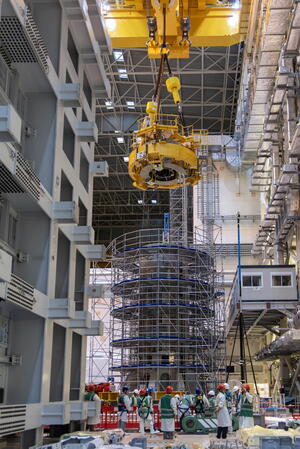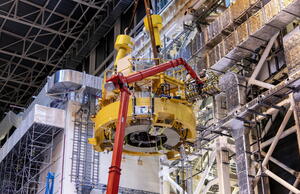5th module (out of 6) installed
Images abound to describe the central solenoid, the backbone and “beating heart” of the ITER tokamak. The most striking of all describes the giant superconducting electromagnet as powerful enough to lift an aircraft carrier out of the water. This is not, of course, what the 18-metre-tall, 1,000-tonne component is intended to do: in ITER, the central solenoid will generate a magnetic field that will induce and maintain a powerful pulsed current in the plasma while contributing to controlling and shaping it.
The ITER central solenoid comprises six 110-tonne cylindrical “modules,” which must be stacked on top of one another, precisely aligned, and connected. On Tuesday 4 November, the monster component came one step closer to completion with the installation of a fifth module on top of the existing stack.
Using the terms “stack” and “stacking,” however, does not convey the extreme complexity of the operation. Modules are delicate components that cannot be handled like other loads, however large or heavy. As their shape and structure do not permit the bolting or welding of conventional lifting devices, operators rely on a set of purpose-built tools—such as a three-pronged lift attachment to balance the cylindrical load, a circular lift frame with friction pads that grasp the modules like hands holding a bowl of cereal, slings, and actuated screw jacks.
As in every phase of ITER assembly, pre- and post-lift metrology plays a key role in the ultra-precise positioning of the component. Lasers, module positioner tools, and fine pitch screws all contribute to achieving sub-millimetre adjustments.
The positioning of what the team refers to as the “upper modules” (the fifth was the second in that category) comes with added challenges. Extending vertically from the existing stack, the helium-cooled busbar lead extensions that feed the 40 kA electric current to the magnets need to pass through the narrow space between the module proper and the circular lift frame without touching either as the module descends or as the lift tool is removed. Any contact with the narrow tower supporting the fragile extensions presents a risk that must be avoided at all costs.
Standing in a cherry picker close to the module, Carl Cormany, the superconducting engineer who supervised the operation and the workers from the Chinese consortium CNPE, spent quite a lot of time monitoring the last phase of the installation from that close observation point; cameras positioined in two locations also helped the team in their surveillance.
The installation of the sixth and last module is tentatively scheduled for March 2026. This will not be the end of the story however, as a compression structure, tasked with applying downward precompression on the module stack, must be put in place. The completed central solenoid will remain on its platform in the Assembly Hall until all nine vacuum vessel sector modules are installed in the tokamak pit.
Watch a timelapse video of the operation below.




